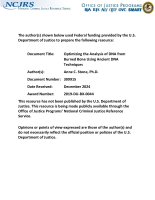Bone analysis
Bone Mineral Density Adult Age Estimation in Forensic Anthropology: A Test of the DXAGE Application
Application of the Optimized Summed Scored Attributes Method to Sex Estimation in Asian Crania
A Study on the Asymmetry of the Human Left and Right Pubic Symphyseal Surfaces Using High-Definition Data Capture and Computational Shape Methods
The Role of Simulated Data in Making the Best Predictions (from the 87th Annual Meeting of the American Association of Physical Anthropologists - 2018)
Metric Ancestry Estimation from the Postcranial Skeleton
Forensic Fractography of Bone A New Model for Skeletal Trauma Analysis
Fractography is a tool for studying material failure. Analysis of cracks and fractures can reveal information about how, why, and where a fracture initiated and how a crack traveled, providing insight into the cause of failure. This webinar provides a basic introduction to forensic fractography of bone, which represents a new model for skeletal trauma that emphasizes understanding the cause of material failure rather than simply classifying fracture patterns.
This webinar was hosted by the NIJ Forensic Technology Center of Excellence on November 2, 2022.
See the YouTube Terms of Service and Google Privacy Policy



